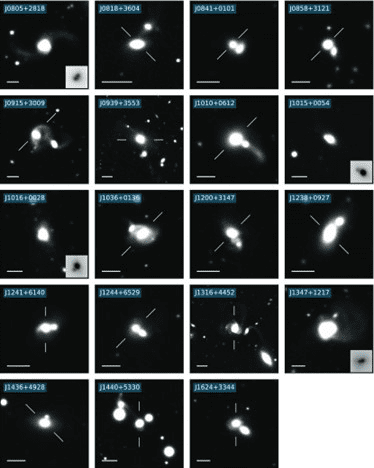The question of why some galaxies have quasars at their core, and most do not, has finally been largely answered. The explanation indicates that in the far distant future, the Milky Way may host a quasar, with big implications for its development.
The discovery of immensely bright objects in the distant universe caused great consternation in the late 1950s and early 60s. Dubbed quasi-stellar objects, subsequently shortened to quasars, it quickly became clear that these enigmas were only around the size of the Solar System, yet could shine with the light of a trillion stars.
Eventually, astronomers concluded quasars gain their power from gas falling into supermassive black holes. However, most galaxies have supermassive black holes and only a few host quasars. The question of what causes the difference has now been answered in a new paper.
A team sought the answer by looking not at the quasars themselves, but the outer reaches of 48 relatively nearby host galaxies, which were compared to more than 100 non-quasar counterparts. They found distinctive distortions to the shape of two-thirds of the quasar galaxies, indicating they had recently experienced a close encounter, or full merger, with a massive counterpart.
The interactions with neighboring galaxies drive at least 0.2 solar masses of gas a year, which would otherwise orbit the supermassive black hole at a safe distance, into the maw for at least a million years, turning the quasars on. The phenomenon is temporary. Not only do the galaxies eventually run out of gas, but the energy released by the quasar drives more distant gas out of the galaxy entirely, ending star formation until restarted by some more modest neighborly interaction.
There are no known quasars within 600 million light-years of Earth, which once led them to be considered a phenomenon of the early universe that has now ceased. Certainly, it was easier for quasars to ignite when galaxies were young and most of their gas had yet to turn to stars. Nevertheless, quasars can still occur today under the right conditions, and one such case could be coming to our cosmic doorstep.
“Quasars are one of the most extreme phenomena in the universe, and what we see is likely to represent the future of our own Milky Way galaxy when it collides with the Andromeda galaxy in about five billion years,” study author Professor Clive Tadhunter of the University of Sheffield said in a statement.
Galactic mergers are common – the Milky Way has been through many on its path to becoming the giant it is today – but not all create quasars. Tadhunter and co-authors found similar outer reach distortions in a fifth of the non-quasar galaxies in their study, although they suspect many of these once had quasars that have since quenched.
Distinguishing what makes some, but not all, mergers quasar-forming may take some time. Nevertheless, the pattern the authors observed is too strong to be a coincidence.
One of the authors’ findings went against expectations. It had been thought quasars only ignite around the peak of galaxy mergers, and would be seen later once the shrouding gas and dust clears. However, the paper reports the majority of disturbed galaxies with quasars in their sample were still “in the pre-coalescence phase”, indicating enough gas is funneled to the center to cause ignition quite early in the process.

The subset of the sample that contain quasars and are in the process of merging with another galaxy, but that merger has yet to reach climax.Image Credit: Pierce et al/Monthly Notices of the Royal Astronomical Society
Moreover, the authors write; “We further emphasize that, while our results present strong evidence that galaxy interactions are the dominant trigger for type 2 quasars in the local universe, it is unlikely that they are the sole trigger.” Internal processes must account for the other cases and might be a bigger factor for more distant quasars.
The study is open access in the Monthly Notices of the Royal Astronomical Society
Source Link: Quasar Formation Mystery Solved After 60 Years